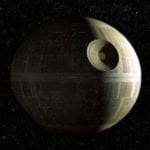 Weird Stuff
Weird Stuff  Weird Stuff
Weird Stuff  Our World
Our World 10 Ways Your Christmas Tree Is More Lit Than You Think
 Movies and TV
Movies and TV The 10 Coolest Stars to Set Sail on The Love Boat
 History
History 10 Things You Didn’t Know About the American National Anthem
 Technology
Technology Top 10 Everyday Tech Buzzwords That Hide a Darker Past
 Humans
Humans 10 Everyday Human Behaviors That Are Actually Survival Instincts
 Animals
Animals 10 Animals That Humiliated and Harmed Historical Leaders
 History
History 10 Most Influential Protests in Modern History
 Creepy
Creepy 10 More Representations of Death from Myth, Legend, and Folktale
 Technology
Technology 10 Scientific Breakthroughs of 2025 That’ll Change Everything
 Weird Stuff
Weird Stuff Ten Bizarre Facts About The Doge Meme
 Our World
Our World 10 Ways Your Christmas Tree Is More Lit Than You Think
 Movies and TV
Movies and TV The 10 Coolest Stars to Set Sail on The Love Boat
Who's Behind Listverse?

Jamie Frater
Head Editor
Jamie founded Listverse due to an insatiable desire to share fascinating, obscure, and bizarre facts. He has been a guest speaker on numerous national radio and television stations and is a five time published author.
More About Us History
History 10 Things You Didn’t Know About the American National Anthem
 Technology
Technology Top 10 Everyday Tech Buzzwords That Hide a Darker Past
 Humans
Humans 10 Everyday Human Behaviors That Are Actually Survival Instincts
 Animals
Animals 10 Animals That Humiliated and Harmed Historical Leaders
 History
History 10 Most Influential Protests in Modern History
 Creepy
Creepy 10 More Representations of Death from Myth, Legend, and Folktale
 Technology
Technology 10 Scientific Breakthroughs of 2025 That’ll Change Everything
10 Earth Secrets That Sound Like Sci-Fi
Arguably, the most interesting planet we know of—Earth—holds a lot of secrets. Some, like the origin of life, may never be revealed. But other secrets, including how a lava-lamp-like blob of magma helped humans conquer the planet, are constantly coming to light.
In addition to revealing the fascinating features of our blue-green-and-sometimes-brown planet, the following revelations sound like they’re plucked straight from science fiction. But as the quote goes, reality is often stranger than sci-fi.
Related: Top 10 Places On Earth With Reoccurring Unsolved Mysteries
10 Earth’s Weird Hidden Blobs from an Ancient Planet (That Gave Us the Moon)
Earth is pretty old, almost 33% of the age of the universe, which is an impressive figure in terms of longevity. Our planet has also survived some insanely destructive events, like a cataclysmic collision with another planet.
About 4.5 billion years ago, our fledgling space rock was hit by another fledgling space rock that was about the size of Mars. This impactor, named Theia, actually helped us because it gave us our Moon, as soon as all the smashed, molten, orbiting bits of rock coalesced. It may also have left a remnant of itself wedged deep within our own planet, in the form of two continent-sized blobs in the mantle, beneath Earth’s crust.
We know of them because these blobs react weirdly to seismic waves (vibrations, like those made by earthquakes) and could explain what happened to the bits of Theia that didn’t get Moon-ified, in slightly-not-so-scientific terms.[1]
9 Auroras Appeared All over the Planet 41,000 Years Ago
Imagine being an early human, minding your business and hunter-gathering on a fine day, say a Tuesday, 41,000 years ago. Maybe you just speared a giant sloth or found some tasty berries, then the entire sky begins to glow.
This isn’t a sci-fi plot, but a real happening that occurred due to Earth’s weakened magnetic field. This was the last time Earth’s magnetic field underwent a massive shift, and our ancestors witnessed skies “ablaze with aurora, from polar regions to the equator.” The auroras were stronger and also not great for health, because our magnetic shield nearly collapsed—it was only around 10% of today’s strength.
As a result, these ancient humans witnessed a nightly show, paired with high amounts of radiation, both from the Sun and the cosmos. In addition to irradiating us pretty good, such an event today would basically knock out our telecommunications capabilities.[2]
8 Earth Grew a Second Core
Earth has two cores: a molten outer core and a solid inner core. We should all be happy that it does, because the swirling of the liquid-iron outer core helps us not die. It’s also one of the reasons we exist in the first place. Nearly 2,000 miles below our feet, Earth’s interior iron roiling gives us the magnetic field that protects us from the Sun’s deadly radiation.
But it wasn’t always so strong. About 565 million years ago, the magnetic field lost about 90% of its strength. Then, in a geologic eye-blink, it regained its strength over a few tens of millions of years, right before an explosion of complex life mysteriously occurred.
Why? Around 550 million years ago, the solid inner core began forming, “recharging” the outer, liquid core, according to University of Rochester researchers. This inner core was vital, potentially stopping Earth from turning into another barren Mars.[3]
7 Earth’s Molten Interior Helped Ancient Humans Migrate
As just mentioned, Earth is a big marble that’s molten in the middle, and that molten middle has affected us in many weird and surprising ways. Now, geoscientists say that Earth’s inner roiling may have helped our ancient ancestors spread to foreign lands.
As per the study, 50-60 million years ago, a huge plume of melted rock began “boiling up” and smashing its way toward the crust. It eventually caused the formation of a land bridge, linking Africa and Asia circa 20 million years ago. The bridge, stretching through the Arabian Peninsula and Anatolia (Turkey), could be an “important part in the story of human evolution.”
This uplifted piece of land allowed mass migrations of rhinos, cheetahs, elephants, and giraffes (oh my). It also afforded early humans a way to reach Asia. The hot-rock action, in combination with plate tectonic activity, also ended one big sea, the Tethys Sea, and created two famous ones: the Mediterranean and Arabian seas. It also ended Africa’s 75 million years of continental isolation.[4]
6 Crystals More Than 4 Billion Years Old Reveal Earth’s History
It’s pretty fascinating every time archaeologists find a 100-year-old can of peas. Still, the timespans of discovery go so far back that it’s insane. Case in point: scientists discovered the oldest piece of the Earth: 4.4 billion years old.
It’s zircon, a really tough old mineral that’s kind of indestructible, withstanding everything Earth threw at it for nearly the entire history of the Earth. It and its fellow zircons preserve ancient history. Scientists can decode their “chemical fingerprints” to find out about the earliest Earth, including the Hadean eon, which is named after hell (Hades), stretching back about 4.5 billion years.
It includes the hundreds of millions of years when the planet was a giant molten rock getting pelted by space rocks the size of small planets. But the little zircon suggests that parts of the planet were already covered by water not long after, way back 4.3 billion years ago. Multiple types of wet environments apparently existed, potentially kickstarting the magically mysterious processes that created life.[5]
5 Mongolia Used to Have an Ocean
One of nature’s most amazing aspects is its mutability. Barren regions may have been seas long ago, and vice versa. Among the gnarliest examples is the Mongolian Ocean. Now it’s a steppe, but around 400 million years ago, it was not. Back then, a big molten glob of rock from Earth’s mantle started floating up, lava-lamp style, and opened Mongolia to create an “ocean that survived for 115 million years.”
This long-gone age was called the Devonian period, lasting from 419 million to 359 million years ago. In addition to violent changes like the Mongol-Okhotsk Ocean, it’s also known as the Age of the Fishes because water-logged creatures began colonizing the land.
Such molten uprisings can be the first step in the Wilson cycle, which breaks continents and opens oceans, as per the formation of the Atlantic Ocean.[6]
4 Deep Sea Anomaly Caused by Supernova Blast?
There’s too much of a weird cosmic metal in the sea, possibly due to Earth being blasted by an exploding star.
Radiocarbon dating works by comparing different types of carbon, since one certain type is unstable and turns into a more stable type of carbon over time. But this only works going back about 50,000 years.
For older things, you need to look at the decay of a particular type of beryllium, a metal, which forms when cosmic radiation slams into the Earth’s atmosphere. Accordingly, scientists recently described a weird anomaly, finding way too much beryllium deep in the Pacific Ocean.
The coolest potential explanation? A near-Earth supernova, a neighboring star that exploded spectacularly 10 million years ago and showered our planet with its star guts, potentially dousing our slightly younger planet in a star-sized dose of radiation.[7]
3 A 3.47-Billion-Year-Old Crater
Craters usually don’t last long on Earth because they get weathered down and erode away. But the oldest discovered crater doesn’t play by the rules and has survived throughout most of our planet’s history.
The Pilbara Crater in northwest Australia is considered 3.47 billion years old, or about a billion years older than the previously oldest known crater, also in Australia. When it was created, it was immense, more than 60 miles (96.6 km) wide. The aftermath of the impact can also be seen as a 22-mile (35.4-km) wide raised area in the middle of the crater, because gigantic impacts create pimple-like domes.
The impact also caused rain of molten droplets across Earth, with some of these hardened ancient droplets possibly found as far away as South Africa. Overall, the impact may have been as catastrophic as the dinosaur-killing asteroid 65 million years ago.[8]
2 Our Oceans Were Green for a Very Long Time
Our blue oceans have inspired awe and motivational posters for countless generations. But they weren’t always so blue, according to a simulation that shows our ancient seas were green!
A group of researchers from different Japanese institutions modeled a whole bunch of stuff, including the chemical makeup of the seas and atmosphere. Billions of years ago, the atmosphere had more vapor and carbon dioxide, speeding up land erosion and causing extra iron to seep into the seas.
Since the iron was electrically charged, it caused a weird oceanic light show in which every color other than green was absorbed, leaving green light to be reflected. Additionally, Earth’s oceans were larger in the past, giving our planet a green-marble appearance. This “pale green dot,” if you’ll excuse an alteration of Carl Sagan’s timeless quote, lasted from around 3 billion years ago to about 600 million years ago. Since little lifeforms (cyanobacteria) were pumping out oxygen, it eventually reacted with the ocean’s dissolved iron to give today’s tranquil blue hue.[9]
1 North America Is Dripping
Not to alarm you, but North America is sinking. Not in water, but into the Earth itself. New science reveals that the underside of the North American continent is dripping into the Earth, through a process known as “cratonic thinning.” Researchers from the University of Texas at Austin say this is the first time we have seen this happen live.
You’d think that big chunks of rock are pretty solid and stable, and that’s what a craton is, a hunk of very old rock that forms part of our continents. These cratons can persist as they are for billions of years, but sometimes they don’t. Why did this particular rock hunk start dripping? Scientists say it may be due to the remnants of a subducting tectonic plate, or sinking deeper into the Earth.
As it goes down, a bunch of the U.S. Midwest’s foundation is following suit and dripping deep into the Earth. Luckily for Midwesterners, this is a slow process that is projected to stop once the sinking tectonic plate gets too deep within the Earth. So, no, this won’t hollow out the continent and cause a collapse into the Earth’s bowels—though that would be a cool disaster-movie plot.[10]








